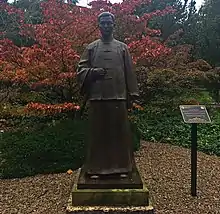Wong Fun
Dr. Wong Fun (simplified Chinese: 黄宽; traditional Chinese: 黄寬; pinyin: Huang Kuan; 1829–1878) was one of the first Chinese to study in Europe. After completing his medical degree at the University of Edinburgh, he returned to China and disseminated what he had learned.

Biography
A native of Hsiang-shan, Canton, Wong studied at Morrison Education Society School, in Macao. In 1847, he and two others, Wong Shing and Yung Wing, became the first three Chinese students to the study in the United States. After graduating in 1850 with a degree in literature from Monson Academy in Massachusetts,[1] Wong Fun went to the University of Edinburgh in Scotland in 1850 through the financial support of the Edinburgh Medical Missionary Society and completed his studies in medicine in 1855.[2][3][4]
Wong stayed in Edinburgh as an intern until 1857, after which he returned to Hong Kong. The next year, he opened a dispensary in Canton working for the London Missionary Society. This brought about a new generation of doctors who saw a wealth of knowledge in Western medicine.[5]
In 2007, Principal Timothy O'Shea of the University of Edinburgh presented Wong Fun's transcripts and exam results to his hometown in China. In return, a bronze statue of Wong Fun was erected at the University of Edinburgh in September of that year.[2]
See also
- Yung Wing
 Plaque honoring Dr. Wong Fun in the University of Edinburgh
Plaque honoring Dr. Wong Fun in the University of Edinburgh - List of Chinese physicians
References
- Xie, Dingjian (30 April 2019). "Wong Fun". UncoverED. University of Edinburgh. Retrieved 9 May 2019.
- "Huang Kuan (Wong Foon): First Chinese to Study in Europe". Zhuhai Municipal Government. 1 March 2017. Retrieved 2017-06-13.
- Fun, Wong (1855). On functional disorders of the stomach (Thesis). University of Edinburgh. hdl:1842/23908.
- Su, Jing (2019). Xīyī lái huá shí jì 西醫來華十記 [Ten Stories of Western Doctors Coming to China]. Taipei: Eculture. ISBN 9789577110794.
- Choa, G. H. (1990). "Heal the Sick" was Their Motto: The Protestant Medical Missionaries in China. Hong Kong: Chinese University Press. p. 80. ISBN 978-962-201-453-4.